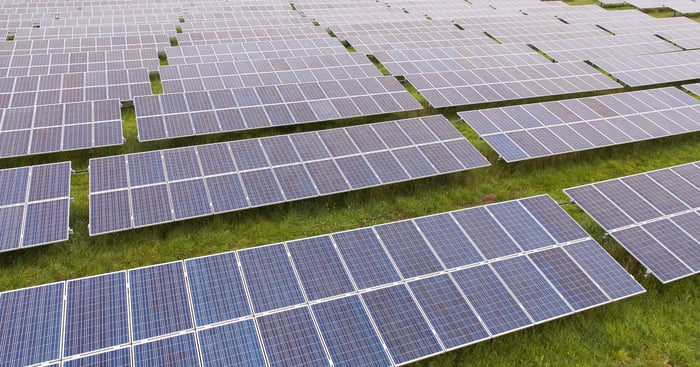The global solar power manufacturing sector is rapidly expanding due to technological advances, cost reductions, and increased government support. Rising greenhouse gas emissions are driving the need for clean energy solutions and positioning solar power as a key focus in the fight against climate change. As countries work to meet climate goals under the Paris Agreement and prioritize clean energy, there is a growing need for domestic manufacturing to reduce import dependence and strengthen energy security.
indian sun landscape
India’s goal of achieving 500 GW of renewable energy by 2030 relies heavily on solar power, which is expected to account for more than 60% of total electricity generation. To achieve this goal, India needs to expand its solar capacity to 50-60 GW per year.
By FY24, India has installed over 80 GW of solar power capacity. However, the country faces major challenges in meeting this demand domestically, as the solar power manufacturing sector remains heavily dependent on imports, particularly from China.
India increased its solar module capacity by 20.8 GW and solar cell capacity by 3.2 GW in 2023 alone. According to forecasts, within the next five years, India’s solar module manufacturing capacity is expected to exceed 150 GW and solar cell production capacity to exceed 75 GW, which will help reduce import dependence and increase renewable energy. This is an important step towards achieving this goal.
However, India’s solar power manufacturing sector mainly assembles solar modules from imported components such as polysilicon and wafers, and local value addition is only 30-40%. Furthermore, the country does not produce solar cells using domestic raw materials such as silica sand, increasing its dependence on imports. As a result, India’s domestic manufacturing sector is operating at only 40-45% capacity utilization, with an operating capacity of 7GW, meeting only about 35% of domestic demand.
Companies like Adani, Waaree are now shifting their focus to domestically manufacturing the entire solar power value chain (from silica to modules), which could increase India’s domestic value added share by 2030. There is.
Global status of solar power manufacturing
Governments and businesses around the world are looking to bring entire value chains in-house to reduce costs, improve operational efficiency and create more job opportunities. However, countries face major obstacles to this strategy, including China’s stronghold, constantly evolving technology, and a mature export market for the sector.
China’s stronghold in the solar power manufacturing value chain
China’s competitive advantage stems from large-scale production, low electricity costs, and fully integrated manufacturing processes, which allow Chinese companies to offer solar power equipment at lower prices than Indian manufacturers. Masu.
Furthermore, China’s heavy investment in research and development and strong government incentives have established China as a dominant player in the global solar power market, accounting for over 80% of global solar power production. is in control. China can produce solar modules at 30 to 65 percent lower cost than the United States or Europe, giving the country a competitive advantage in the global market.
Over the past decade, global solar manufacturing capacity has increasingly shifted from Europe, Japan, and the United States to China. China is investing more than $50 billion in new solar power capacity, 10 times more than Europe.
Continually evolving solar power generation technology
Passivated Emitter and Rear Contact (PERC) cells remain the mainstream, but innovations such as n-type-based TOPCon cells and silicon heterojunction (SHJ) cells are gaining traction due to improved efficiency and performance at lower cost. is increasing. Additionally, breakthroughs are emerging, such as perovskite-silicon tandem solar cells with efficiencies greater than 30% (currently their implementation is limited by module lifetime).
These next-generation technologies promise significant improvements in efficiency, material usage, and power output, and are positioned as key drivers of global growth in solar energy. India needs to embrace these advances if it is to remain competitive. Without these cutting-edge technologies, India risks falling behind the evolution of the global solar power industry.
India’s solar power manufacturing sector also faces technological challenges. Monocrystalline modules account for 67.5% of total production. Polycrystalline modules follow with 15.1%, followed by Tunnel Oxide Passivated Contact (TOPCon) modules and thin film technology with shares of 12.3% and 5.1%, respectively. Meanwhile, China is moving towards n-type based technologies (TOPCon and SHJ), achieving massive cost efficiencies.
Mature export market and India’s dependence
China’s solar module exports increased by 34% year-on-year, increasing from 85GW in the first half of 2022 to 114GW in the same period this year, almost equal to the total export volume in 2021. This amount could potentially power Sweden and is equivalent to an entire solar power system. US capacity (113GW).
In 2023, India imported 16.2GW of solar modules, an increase of 158% year-on-year, and 15.6GW of solar cells, an increase from 5.8GW in 2022. India’s solar module exports will reach 4.8GW in 2023, an increase of 204% from the previous year. However, these exports remain modest compared to imports, highlighting continuing limitations. High domestic manufacturing capacity in India.
China is India’s largest supplier, supplying solar cells and modules worth USD 3.89 billion, accounting for 62.6% of total imports. This was followed by Vietnam (US$1.02 billion, 16.5%), Malaysia (US$549.8 million, 8.9%), and Thailand (US$248.8 million, 4%).
Strategy for transition to domestic production
Friendly regulatory policy:
Governments around the world are implementing friendly financial policies to develop local manufacturing infrastructure, but the scale of these efforts varies by region.
The Government of India has introduced the Approved List of Models and Manufacturers (ALMM) and Production-Linked Incentive (PLI) schemes to encourage local manufacturing, protect domestic manufacturers and maintain quality standards. These measures are aimed at reducing import dependence and increasing the efficiency and sustainability of India’s solar power manufacturing sector.
The U.S. Inflation Control Act (IRA) disburses investments in the manufacturing and assembly of key renewable energy components such as solar panels and wind turbines. Investment in and production of clean energy sources is done to benefit PTC and ITC by employing domestic labor. Manufacturers are eligible for a tax credit of up to 30%. The IRA aims to invest up to US$50 billion to expand domestic manufacturing.
China offers a variety of subsidies, tax rebates and low-interest loans to solar power manufacturers. These incentives have allowed local companies to invest in advanced manufacturing technologies and remain competitive in global markets.
Trade restrictions to reduce China’s influence:
Countries around the world are increasingly implementing tariffs as a strategy to curb imports, protect local industry, and promote domestic growth. These sanctions are expected to further tighten as China continues to dominate this sector.
The Indian government has imposed a 40% tariff on Chinese solar modules and 25% on solar cells, raising installation costs by 20-30% and slowing project growth. Notably, India maintains similarly high tariffs on imported cars: 100% on cars priced above USD 40,000, 60% on cars below, and 60% on used cars. 125%, indicating that such high tariffs on solar imports are not temporary, and may even become so. Increases over time. ”
The United States is proposing to impose a 50% tariff on polysilicon used in solar panels starting in 2025. Currently, most of the United States’ solar panel imports come from Southeast Asia. The US government has doubled the tariffs on Chinese-made panels to 50%.
conclusion
India also needs to focus on increasing upstream solar power production, from raw materials such as silica sand to manufacturing finished solar panels. By building domestic manufacturing capacity for polysilicon, wafers and cells, India can reduce its dependence on imports and improve cost efficiency in its solar PV manufacturing sector.


